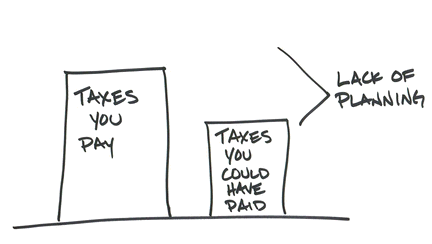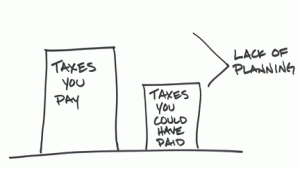The Importance of Tax-Efficient Investing
Mar 10, 2016 • Written by Paul Staib | Certified Financial Planner (CFP®), MBA, RICP®
Blog Home » Asset Allocation » The Importance of Tax-Efficient Investing

When it comes to income, you know that it’s not what you make, but what you keep after taxes that really counts. And these days, with higher capital gain taxes and the 3.8% Medicare investment income surtax (that affects certain filing status thresholds), being mindful of investment taxes is more important than ever.
Return lost to taxes
Several studies have examined the long-term impact of expenses and taxes on investment returns and concluded that, while asset allocation and investment selection are still some of the most important factors affecting returns, minimizing costs and taxes isn’t very far behind.
Because mutual funds may distribute capital gains throughout the year, mutual fund investors are often concerned about losing investment returns to taxes. But, depending on how they manage their investments, individual stock and bond investors are vulnerable to taxes as well.
As disconcerting as a return lost to taxes might be, the good news is you can exercise a good deal of control here. Consider this: Diversification and asset allocation are great tools for helping to reduce portfolio volatility, but despite how diligent we might be in setting up our portfolios and selecting our individual investments, we’re still going to be subjected to the short-term whims of the market. Our greatest degree of control is in the area of expenses and tax-efficient implementation. It makes sense, then, to bring tax-efficiency near the forefront of our investment plan.
How do I try to maximize tax efficiency?
Broadly speaking, investments that tend to lose less of their return to income taxes are good candidates for taxable accounts. Likewise, investments that lose more of their return to taxes sould go in tax-advantaged accounts. Here’s where you might consider placing your investments:
Where tax-smart investors typically place their investments:
Taxable Accounts are ideal for…
- Individual stocks you plan to hold more than one year,
- Tax-managed stock funds, index funds, exchange-traded funds (ETFs), low-turnover stock funds,
- Stocks or mutual funds that pay qualified dividends,
- Municipal bonds, I Bonds (savings bonds)
Tax-Advantaged Accounts (such as Roth IRAs and tax-deferred accounts including traditional IRAs, 401k(s)) are ideal for…
- Actively managed funds that may generate significant shortterm capital gains
- Taxable bond funds, zero-coupon bonds, inflation-protected bonds or high-yield bond funds
Of course, this presumes that you hold investments in both types of accounts. If all your investment money is in your 401(k) or IRA, then just focus on asset allocation and investment selection.
Tax Diversification
Holding your investments in different accounts based on tax treatment (such as taxable and tax-advantaged accounts) can not only add value during the accumulation phase of your financial life by allowing you to defer taxes (or, in the case of a Roth, eliminate entirely the taxes on investment returns), it also adds an additional layer of diversification to your portfolio during the distribution phase in retirement. Call it “tax diversification.”
Diversifying by tax treatment can be especially important if you’re uncertain about whether you’re going to be in a much higher or lower tax bracket down the road. For example, if you’re on the fence, instead of choosing between a traditional IRA or 401(k) and a Roth account, why not split your contributions between the two? When the time comes to start withdrawing money in retirement, you will have greater flexibility to manage your income tax bracket if you’re able to pick and choose which types of accounts you take your cash from. For example, you may want to focus on tax-free municipal bond income, qualified dividends, and long-term capital gains from your taxable accounts, tax-free income from your Roth accounts, and only enough from taxable IRAs to keep you from moving into the next highest tax bracket (or to satisfy required minimum distributions, if applicable).
Utilizing different account types by tax treatment can also help you plan your charitable giving and estate planning goals, as different accounts receive different types of gift and estate tax treatment. For example, you might want to give appreciated securities from your taxable accounts to charity for a full fair market value deduction and no capital gain tax, or leave such shares to your heirs who will receive a step-up in cost basis after you’re gone. Roth IRAs also make a great bequest, since distributions are free from income tax for your beneficiaries.
However you decide to split up your portfolio between account types, remember you still have one portfolio for asset allocation purposes. By way of an oversimplified illustration, if you kept all your stocks in your taxable account and an equal amount of money in bonds in your tax-advantaged account, you wouldn’t have two portfolios consisting of 100% stocks and 100% bonds. You would have one portfolio consisting of 50% stocks and 50% bonds. The different assets just happen to be in different accounts.
Other considerations
In general, holding tax-efficient investments in taxable accounts and less tax-efficient investments in tax-advantaged accounts should add value over time. However, there are other factors to consider, including:
- Periodically rebalancing your portfolio to maintain your strategic asset allocation. This will cause additional tax drag on returns in your taxable accounts because typically, rebalancing involves selling assets that have grown beyond your original allocation and buying assets that have fallen below your original allocation. In other words, you’re taking profits from your winners and buying assets that have underperformed. Also, in taking profits from assets that have grown, you may incur either long- or short-term capital gains. To minimize the chances of this, you may want to focus your rebalancing efforts on your tax-advantaged accounts and include your taxable accounts only when necessary. Keep in mind, adding new money to underweighted asset classes is also a tax-efficient way to help keep your portfolio allocation in balance.
- Active trading by individuals or by mutual funds, when successful, tends to be less tax-efficient and better suited for tax-advantaged accounts. A caveat: Realized losses in your tax-advantaged accounts can’t be used to offset realized gains on your tax return.
- A preference for liquidity might prompt you to hold bonds in taxable accounts, even if it makes more sense from a tax perspective to hold them in tax-advantaged accounts. In other situations, it may be impractical to implement all of your portfolio’s fixed income allocation using taxable bonds in tax-advantaged accounts. If so, compare the after-tax return on taxable bonds to the tax-exempt return on municipal bonds to see which makes the most sense on an after-tax basis.
- Estate planning issues and philanthropic intent might play a role in your portfolio planning. If you’re thinking about leaving stocks to your heirs, stocks in taxable accounts are generally preferable. That’s because the cost basis is calculated based on the market value of the stocks at the time of death (rather than at the time they were originally acquired, when they may have been worth substantially less). In contrast, stocks in tax-deferred accounts don’t receive this treatment, since distributions are taxed as ordinary income anyway. Additionally, highly appreciated stocks held in taxable accounts for more than a year might be well-suited for charitable giving because you’ll get a bigger deduction, and the charity gets a bigger donation, than if you liquidate the stock and pay long-term capital gains tax before donating the proceeds.
- The Roth IRA might be an exception to the general rules of thumb discussed above. Since qualified distributions are tax free, assets you believe will have the greatest potential for higher return are best placed inside a Roth IRA, when possible.
The bottom line
Tax-smart investors hold tax-efficient investments in taxable accounts and less tax efficient investments in tax-advantaged accounts. “Tax diversification” can be important if you’re uncertain about which tax bracket you’ll end up in retirement and can also help with charitable giving and estate planning goals.

Paul Staib | Certified Financial Planner (CFP®), MBA, RICP®
Paul Staib, Certified Financial Planner (CFP®), RICP®, is an independent Flat Fee-Only financial planner. Staib Financial Planning, LLC provides comprehensive financial planning, retirement planning, and investment management services to help clients in all financial situations achieve their personal financial goals. Staib Financial Planning, LLC serves clients as a fiduciary and never earns a commission of any kind. Our offices are located in the south Denver metro area, enabling us to conveniently serve clients in Highlands Ranch, Littleton, Lone Tree, Aurora, Parker, Denver Tech Center, Centennial, Castle Pines and surrounding communities. We also offer our services virtually.
Read Next
Retiring in a Down Market
• Written By Paul Staib | Certified Financial Planner (CFP®), MBA, RICP®
Pre-retirees and new retirees concerned about today’s markets can take steps to protect themselves. The current market rout has been…
Market Volatility: What should I do now?
• Written By Paul Staib | Certified Financial Planner (CFP®), MBA, RICP®
Stock markets have been choppy lately, pressured by all sorts of concerns – including tighter monetary policy, the impact of…

